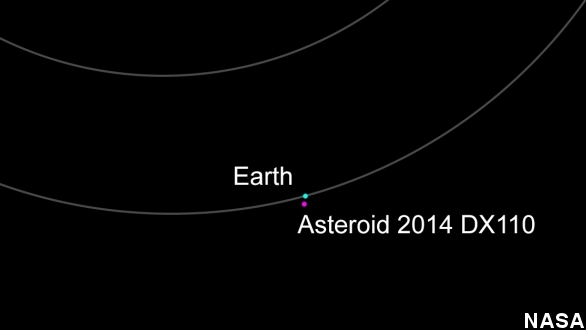Ever since that space rock exploded over Russia last year, it seems like we've been hearing a lot about asteroids lighting up the sky. To no one's surprise, another one ripped through our cosmic comfort zone Wednesday afternoon.
"It's called 2014 DX110. It's estimated to be between 45 and 130 ft. across. And astronomers say it'll fly between the moon and Earth." (Via ABC)
DX110 was discovered just last Friday. It made its closest approach to Earth at about 216,000 miles away — or 90 percent of the average distance from Earth to the moon — just after 4 p.m. ET Wednesday. (Via Space.com)
Judging by this picture on NASA's website, that looks like a pretty close call, but scientists continually reiterated that the asteroid would make a "safe pass" by Earth. According to NASA, events like this happen around 20 times a year.
Wednesday's asteroid couldn't be seen with the naked eye, but Slooh, a service that livestreams telescopic images, gave viewers live pictures of the faint fly-by during a 15 minute broadcast.
Viewers also might've caught a quick sidenote from Slooh Host and Observatory Director Paul Cox. He responded to people who he claims are calling the often and ongoing news focus on asteroids "scare mongering."
"We're doing our best to keep this whole subject in the news. So it's not us scare mongering. This is us highlighting what a serious threat these objects pose to Earth."
A writer at Slate says "Averaged over time, a 25 meter asteroid is expected to hit us very roughly every 50 years or so," mostly over the ocean or in some uninhabited territory.
But some, like the one over Chelyabinsk, Russia, can be devastating. That one exploded in the atmosphere with an estimated force of 50,000 tons of TNT. (Via YouTube / Никита Кырчиков)
Slooh announced they'll broadcast another asteroid fly-by Thursday night. This one is expected to come a little closer than DX110 at 37,000 miles away from Earth.


